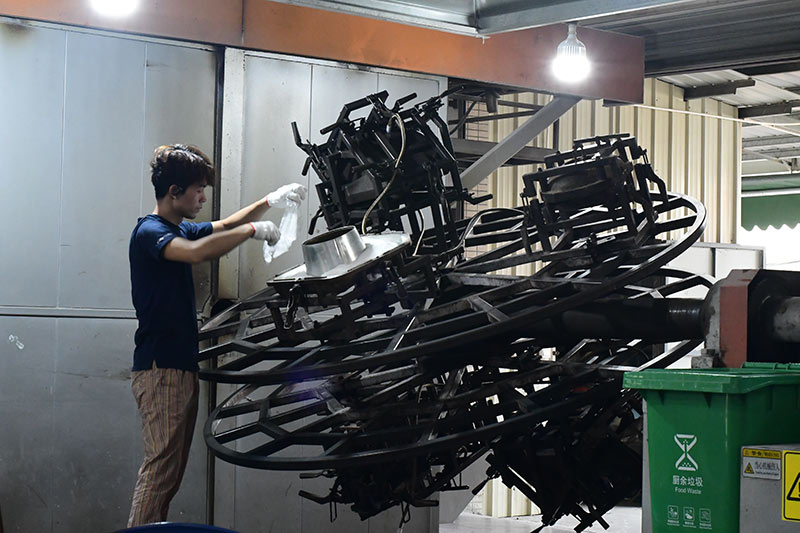Analysis of Causes and Solutions for Color Uniformity Issues in Rotomolding Process
 Oct 29,2024
Oct 29,2024

Analysis of Causes and Solutions for Color Uniformity Issues in Rotomolding Process
The analysis of causes and solutions for color uniformity issues in rotomolded products is a complex topic that requires a deep understanding of the rotomolding process and the properties of the materials used. Here is an overview of the common causes of color uniformity issues and some potential solutions

Causes of Color Uniformity Issues
1. Material Inconsistencies
- Inconsistent Pellet Quality: Variations in the quality of plastic pellets can lead to color inconsistencies. Pellets from different batches may have slight differences in pigment concentration or distribution.
- Moisture Content: High moisture content in the plastic can cause discoloration and affect the uniformity of the color.
2. Mixing and Melting
- Inadequate Mixing: One of the primary causes of color uniformity issues is the inadequate mixing of colorant in the polymer resin. If the colorant is not properly mixed, it can lead to variations in color throughout the product, resulting in unevenness.
- Temperature Variations: The temperature during the rotomolding process plays a crucial role in achieving color uniformity. If there are temperature fluctuations or inconsistencies, it can affect the melting and flow of the colorant, leading to variations in color
3. Mold Design
- Poor Mold Design: Molds with inadequate venting or uneven wall thickness can cause trapped air or uneven cooling, leading to color variations.
- Wear and Tear: Over time, molds can wear down, affecting the uniformity of the product's color.
4. Processing Parameters
- Rotation Speed: The speed at which the mold is rotated can impact the distribution of the molten plastic and, consequently, the color uniformity.
- Dwell Time: The time the material spends in the heated zone can affect the color uniformity if not controlled properly.
5. Additives and Pigments
- Degradation of Pigments: Exposure to high temperatures or UV light can degrade pigments, leading to color fading or uneven distribution.
- Incompatibility: Some additives may not be compatible with the base plastic, causing color issues.
Solutions for Color Uniformity Issues
1. Material Quality Control
- Consistent Pellet Sourcing: Ensure that all plastic pellets used are from the same batch to maintain uniformity in pigment concentration.
- Dry the Material: Use a desiccant or dehumidification system to reduce moisture content in the plastic pellets.
2. Optimize Mixing and Melting
- Enhance Mixing: Use high-shear mixers to ensure thorough mixing of the plastic pellets and colorants.
- Control Temperature: Monitor and maintain consistent temperatures throughout the melting process to prevent color variations.
3. Mold Improvements
- Optimize Mold Design: Ensure proper venting and uniform wall thickness in the mold design to prevent trapped air and uneven cooling.
- Regular Maintenance: Perform regular inspections and maintenance on molds to minimize wear and tear.
4. Adjust Processing Parameters
- Control Rotation Speed: Adjust the rotation speed to ensure even distribution of the molten plastic within the mold.
- Manage Dwell Time: Control the dwell time to ensure that the material spends an adequate amount of time in the heated zone for uniform color development.
5. Use of Additives and Pigments
- Stabilize Pigments: Use pigments that are stable under high temperatures and UV exposure to prevent degradation.
- Compatibility Testing: Conduct compatibility tests to ensure that all additives and pigments are compatible with the base plastic.
By identifying the causes mentioned above and implementing appropriate solutions, manufacturers can significantly reduce color variations and produce high-quality, aesthetically pleasing rotational molded products. Ensuring proper material handling, mixing, mold design, curing, and resin quality are essential steps in achieving consistent coloration in rotomolding processes.
 Tel: 0086-13632687993
Tel: 0086-13632687993  Email: roto@lightvenus.com
Email: roto@lightvenus.com

 Home
Home What are the Key Advantages of Rotational Molding in Automotive Industry?
What are the Key Advantages of Rotational Molding in Automotive Industry?  You May Also Like
You May Also Like



 Tel
Tel
 Email
Email
 Address
Address








